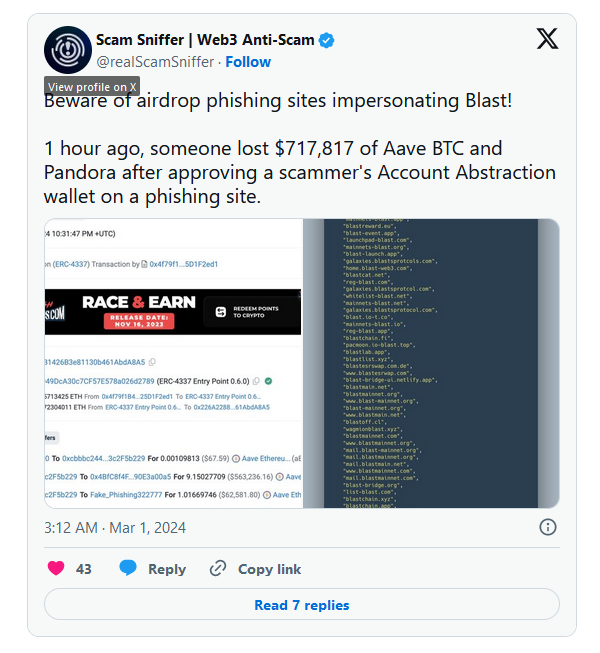Unknown person loses over $717 000 in a phishing attack using a fake Blast website
The project had previously launched the mainnet, which drew increased attention from attackers

01.03.2024 - 13:27
364
3 min
0
Last updated on Aug 5, 2024
What’s new? Experts of the analytics platform Scam Sniffer have recorded a major phishing attack, realized with the help of a fake website of the Layer 2 (L2) network Blast based on the Ethereum blockchain from the creators of the Blur NFT marketplace. Thus, on March 1, an unknown user lost $717 817 in Aave BTC and Pandora assets by connecting his wallet to the fake website of Blast’s airdrop.
What else is known? Scam Sniffer called for vigilance as scammers creating fake Blast websites have become more active due to the recent launch of the project’s mainnet.
Thus, the launch of the Blast mainnet took place on February 29, allowing users to start using the ecosystem’s exclusive decentralized applications (DApps), as well as withdraw funds blocked in the protocol.
The protocol has been operating in early access mode since November 21, by the time the mainnet was launched, 181 888 users had blocked over $2,3 billion in the protocol, and over 3000 teams had started developing ecosystem projects.
The airdrop of the Blast native token is expected to launch in May as well. 50% will be received by users based on the points earned through blockchain funds, another half will be given to the 47 projects that won the Big Bang competition.
It also became known about the first case of scam of a Blast-based project. The developers of the RiskOnBlast gaming platform withdrew 420 ETH users for the amount of $1,25 million, deactivated the website and social networks, and transferred the funds to the exchanges ChangeNOW, MEXC, and Bybit. Over 750 users were affected.
On January 22, an unknown person lost $4,2 million in Aave Ethereum WETH, and Aave Ethereum UNI coins in a phishing attack.
Earlier, the MetaMask wallet team partnered with Blockaid to implement a mechanism to protect users from phishing attacks.
Useful material?
Incidents
This status has been maintained for the first cryptocurrency since September 2021 but was canceled due to pressure from the IMF
Feb 3, 2025
Market
The Taproot Assets network will be used for the integration
Jan 31, 2025
Market
The index has grown by more than 535% over the entire period
Jan 30, 2025
Trends
As of January 21, the capitalization of this sector of the crypto market exceeds $519 billion
Jan 21, 2025
Market
The platform generated $9,5 million in revenue during the same time
Jan 20, 2025
Market
Shares of the Trust are designed to track the market price of XRP with fewer fees and expenses
Jan 17, 2025











 Telegram
Telegram  Twitter
Twitter